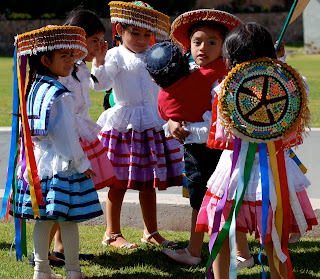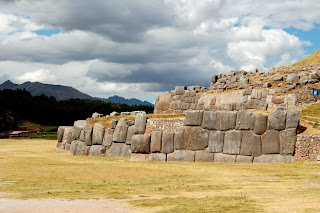Our wake up call was at 3 AM, and breakfast was ready for us, but consisted of a few pieces of toast and coffee. Driving through Lima at 4 in the morning was considerably easier than during the rush hour. The airport was full of people going in all sorts of directions, and a significant number were traveling to Cusco. I was too excited during the flight to catch up on sleep. I had a window seat and watched the arid mountains float by. I was surprised that the towns and settlements were at the top of the mountains and not in the valleys, but generally the terrain was dry and unfriendly and the population was scarce.
Cusco was a pleasant surprise. It is a small city of about 300, 000 inhabitants in a large valley at an altitude of about 11,000 feet. The mountains surrounding the town had a reddish tinge, as did the colonial buildings, so the whole effect was charming and inviting. I was too excited to rest once we settled into our hotel room (but I insisted that Maya and Eric sleep!). I wandered up the street from the hotel, walking by the 'Koricancha', which is the original Incan Temple of the Sun covered by the church that the Spaniards built around and on top. There were hundreds of children in costumes along with parents and teachers. They were preparing for a parade commemorating their first day of school. Most of the costumes were traditional and indigenous, but spidermen, superheros, bees, animals and princesses were equally popular. The air was festive and although I was eager to move on, it was too entertaining to watch the kindergarten-aged children and their antics.
 Watching His Brother
Watching His Brother Waiting to Go
Waiting to Go Native Dress
Native Dress Holding the Banner
Holding the Banner Marching
Marching Parade Goes By
Parade Goes By Great Costumes
Great Costumes Getting Tired
Getting Tired Waiting to Go
Waiting to Go All Wrapped Up
All Wrapped Up Playing Games at Koricancha
Playing Games at Koricancha Balloons and Bubble Gum
Balloons and Bubble GumI had to rush back to the hotel to get Maya and Eric out of bed and moving. We met Sherry and Jeff for lunch, and took another walk up the hill to the Plaza de Armas, where the children were no longer marching; instead they were milling about with their families and eating snacks and running in circles. We ate wonderful food at 'Inka Grill' ( Maya and Sherry tried alpaca meat!) and met our guide 'Edison' back at the hotel just in time for our afternoon tour.
Edison was full of wonderful details about the Incas and their empire, and took us first to 'Sacsayhuaman', a massive hilltop fortress looming over the city and visible from the main plaza. The Inca Pachcutec built this incredible structure, which was both a place of worship and impregnable, with three ramparts of zigzag walls constructed with huge stones (weighing many tons) fitted together perfectly with no mortar. There were once three towers crowning the top, their foundations still visible. I was in awe as we walked along the walls, and wondered how it was possible that these stones had been moved and placed so perfectly together. It was impossible to capture the magnificence of the ruins, despite repeated efforts with both my cameras. Climbing to the top brought us to a wonderful view of Cusco and the valley, and further ruins of a temple. I wanted to stay longer, to touch the walls again, to feel the energy of the place.
 Ruins of Sacsahuaman
Ruins of Sacsahuaman ZigZag Ramparts
ZigZag Ramparts Massive Stones
Massive Stones Perfect Construction
Perfect Construction Maya Posing
Maya Posing Plaza de Armas in the Distance
Plaza de Armas in the Distance Magical Stones
Magical Stones Fabrics for Sale
Fabrics for Sale Maya Posing with Llamas
Maya Posing with LlamasWe drove back to Cusco to visit the Cathedral. It was a difficult trasition to make, after seeing the massive structures at Sascayhuaman. The colonial art was impressive, but on an entirely different scale than the Inca architecture. The interesting aspect of the religious art was that it was mostly indigenous artists who built and carved and painted every inch of the church, and they were able to add or insert something of themselves in their designs, from local flora nad fauna, to traditional dress and typical food. It was an indigenous church as much as a Spanish church. It was huge, but tiny compared to the fortress we just saw.
Our last visit with Edison was Koricancha, the original temple of the sun, which the Spaniards covered with a Dominican church and monastery. Some of original walls remain, with perfectly carved stones that fit together without any air between them, looking solid and stately. I remember that the walls were once covered with gold plates, which the Spanish conquistadors pried off and melted down, along with the golden idols which occupied the niches. The garden beyond the temple was full of golden corn and silver stems, which disappeared when the Spaniards came.
Our last visit with Edison was Koricancha, the original temple of the sun, which the Spaniards covered with a Dominican church and monastery. Some of original walls remain, with perfectly carved stones that fit together without any air between them, looking solid and stately. I remember that the walls were once covered with gold plates, which the Spanish conquistadors pried off and melted down, along with the golden idols which occupied the niches. The garden beyond the temple was full of golden corn and silver stems, which disappeared when the Spaniards came.
I stayed longer at Koricancha, trying to envisage what it must once have looked like covered in gold and shining in the sunshine, but perhaps because it was once so grand and impressive and so little of the original remains, I could not imagine its once impressive appearance.
We were all so tired after our very long day, but after dinner, I decided to visit the Museo de Arte Pre-colombino, and was revived again. A traditional dance performance in the courtyard distracted me as I moved from room to room, once again revisiting the earlier Peruvian cultures I had been introduced to in Lima
What an incredible day. I am overwhelmed. I never imagined that we would see so much, and it is only our first 'Inca' day. We will visit more sites tomorrow in the Sacred Valley, before we take the train to Machu Picchu. There is so much more to see!
 Sunshine in Cusc0
Sunshine in Cusc0

 Andean Desert
Andean Desert Close to Cusco
Close to Cusco Selling Bread at the Parade
Selling Bread at the Parade Ready to March
Ready to March
 Costumes Ready
Costumes Ready Dancing in the Street
Dancing in the Street Dancing with Grass
Dancing with Grass
 Iglesia de la Compañia
Iglesia de la Compañia


 Cathedral
Cathedral Traditional Attire at Plaza de Armas
Traditional Attire at Plaza de Armas

 Mochica Ceramic Head
Mochica Ceramic Head

 More Dancing
More Dancing





No comments:
Post a Comment